+ データを開く
データを開く
- 基本情報
基本情報
| 登録情報 | データベース: PDB / ID: 7s8y | ||||||
|---|---|---|---|---|---|---|---|
| タイトル | Cryogenic apo Human Hsp90a-NTD | ||||||
 要素 要素 | Heat shock protein HSP 90-alpha | ||||||
 キーワード キーワード | Chaperone / Hydrolase / CHAPERONE PROTEIN / SIGNAL TRANSDUCTION / HEAT SHOCK | ||||||
| 機能・相同性 |  機能・相同性情報 機能・相同性情報sperm mitochondrial sheath / sulfonylurea receptor binding / dATP binding / CTP binding / positive regulation of protein polymerization / Scavenging by Class F Receptors / vRNP Assembly / UTP binding / sperm plasma membrane / chaperone-mediated autophagy ...sperm mitochondrial sheath / sulfonylurea receptor binding / dATP binding / CTP binding / positive regulation of protein polymerization / Scavenging by Class F Receptors / vRNP Assembly / UTP binding / sperm plasma membrane / chaperone-mediated autophagy / Rho GDP-dissociation inhibitor binding / Respiratory syncytial virus genome replication / telomerase holoenzyme complex assembly / mitochondrial transport / Uptake and function of diphtheria toxin / Drug-mediated inhibition of ERBB2 signaling / Resistance of ERBB2 KD mutants to trastuzumab / Resistance of ERBB2 KD mutants to sapitinib / Resistance of ERBB2 KD mutants to tesevatinib / Resistance of ERBB2 KD mutants to neratinib / Resistance of ERBB2 KD mutants to osimertinib / Resistance of ERBB2 KD mutants to afatinib / Resistance of ERBB2 KD mutants to AEE788 / Resistance of ERBB2 KD mutants to lapatinib / Drug resistance in ERBB2 TMD/JMD mutants / protein import into mitochondrial matrix / dendritic growth cone / TPR domain binding / PIWI-interacting RNA (piRNA) biogenesis / Assembly and release of respiratory syncytial virus (RSV) virions / non-chaperonin molecular chaperone ATPase / protein unfolding / Sema3A PAK dependent Axon repulsion / regulation of protein ubiquitination / positive regulation of cell size / HSF1-dependent transactivation / response to unfolded protein / enzyme-substrate adaptor activity / skeletal muscle contraction / regulation of protein-containing complex assembly / HSF1 activation / telomere maintenance via telomerase / Attenuation phase / chaperone-mediated protein complex assembly / axonal growth cone / neurofibrillary tangle assembly / regulation of postsynaptic membrane neurotransmitter receptor levels / RHOBTB2 GTPase cycle / positive regulation of lamellipodium assembly / nitric oxide metabolic process / eNOS activation / positive regulation of defense response to virus by host / DNA polymerase binding / Tetrahydrobiopterin (BH4) synthesis, recycling, salvage and regulation / response to salt stress / positive regulation of telomere maintenance via telomerase / Signaling by ERBB2 / cardiac muscle cell apoptotic process / endocytic vesicle lumen / positive regulation of cardiac muscle contraction / Loss of Nlp from mitotic centrosomes / Loss of proteins required for interphase microtubule organization from the centrosome / Recruitment of mitotic centrosome proteins and complexes / activation of innate immune response / lysosomal lumen / Recruitment of NuMA to mitotic centrosomes / Anchoring of the basal body to the plasma membrane / positive regulation of interferon-beta production / ESR-mediated signaling / HSP90 chaperone cycle for steroid hormone receptors (SHR) in the presence of ligand / protein tyrosine kinase binding / response to cold / Constitutive Signaling by Overexpressed ERBB2 / AURKA Activation by TPX2 / nitric-oxide synthase regulator activity / VEGFR2 mediated vascular permeability / response to cocaine / ATP-dependent protein folding chaperone / brush border membrane / Signaling by ERBB2 TMD/JMD mutants / Constitutive Signaling by EGFRvIII / Signaling by ERBB2 ECD mutants / DDX58/IFIH1-mediated induction of interferon-alpha/beta / Signaling by ERBB2 KD Mutants / cellular response to virus / Regulation of actin dynamics for phagocytic cup formation / Regulation of necroptotic cell death / positive regulation of protein import into nucleus / VEGFA-VEGFR2 Pathway / response to estrogen / tau protein binding / Downregulation of ERBB2 signaling / histone deacetylase binding / Chaperone Mediated Autophagy / neuron migration / Aggrephagy / positive regulation of nitric oxide biosynthetic process / positive regulation of protein catabolic process / disordered domain specific binding / MHC class II protein complex binding 類似検索 - 分子機能 | ||||||
| 生物種 |  Homo sapiens (ヒト) Homo sapiens (ヒト) | ||||||
| 手法 |  X線回折 / X線回折 /  シンクロトロン / シンクロトロン /  分子置換 / 解像度: 1.59 Å 分子置換 / 解像度: 1.59 Å | ||||||
 データ登録者 データ登録者 | Stachowski, T.R. / Vanarotti, M. / Lopez, K. / Fischer, M. | ||||||
| 資金援助 |  米国, 1件 米国, 1件
| ||||||
 引用 引用 |  ジャーナル: Angew.Chem.Int.Ed.Engl. / 年: 2022 ジャーナル: Angew.Chem.Int.Ed.Engl. / 年: 2022タイトル: Water Networks Repopulate Protein-Ligand Interfaces with Temperature. 著者: Stachowski, T.R. / Vanarotti, M. / Seetharaman, J. / Lopez, K. / Fischer, M. | ||||||
| 履歴 |
|
- 構造の表示
構造の表示
| 構造ビューア | 分子:  Molmil Molmil Jmol/JSmol Jmol/JSmol |
|---|
- ダウンロードとリンク
ダウンロードとリンク
- ダウンロード
ダウンロード
| PDBx/mmCIF形式 |  7s8y.cif.gz 7s8y.cif.gz | 196.5 KB | 表示 |  PDBx/mmCIF形式 PDBx/mmCIF形式 |
|---|---|---|---|---|
| PDB形式 |  pdb7s8y.ent.gz pdb7s8y.ent.gz | 132.8 KB | 表示 |  PDB形式 PDB形式 |
| PDBx/mmJSON形式 |  7s8y.json.gz 7s8y.json.gz | ツリー表示 |  PDBx/mmJSON形式 PDBx/mmJSON形式 | |
| その他 |  その他のダウンロード その他のダウンロード |
-検証レポート
| 文書・要旨 |  7s8y_validation.pdf.gz 7s8y_validation.pdf.gz | 428.7 KB | 表示 |  wwPDB検証レポート wwPDB検証レポート |
|---|---|---|---|---|
| 文書・詳細版 |  7s8y_full_validation.pdf.gz 7s8y_full_validation.pdf.gz | 430.5 KB | 表示 | |
| XML形式データ |  7s8y_validation.xml.gz 7s8y_validation.xml.gz | 13.1 KB | 表示 | |
| CIF形式データ |  7s8y_validation.cif.gz 7s8y_validation.cif.gz | 19.6 KB | 表示 | |
| アーカイブディレクトリ |  https://data.pdbj.org/pub/pdb/validation_reports/s8/7s8y https://data.pdbj.org/pub/pdb/validation_reports/s8/7s8y ftp://data.pdbj.org/pub/pdb/validation_reports/s8/7s8y ftp://data.pdbj.org/pub/pdb/validation_reports/s8/7s8y | HTTPS FTP |
-関連構造データ
| 関連構造データ | 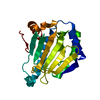 7s8zC  7s90C  7s95C  7s98C  7s99C 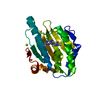 7s9fC 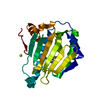 7s9gC  7s9hC  7s9iC 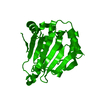 1yerS S: 精密化の開始モデル C: 同じ文献を引用 ( |
|---|---|
| 類似構造データ | 類似検索 - 機能・相同性  F&H 検索 F&H 検索 |
- リンク
リンク
- 集合体
集合体
| 登録構造単位 | 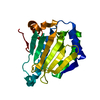
| ||||||||||||
|---|---|---|---|---|---|---|---|---|---|---|---|---|---|
| 1 |
| ||||||||||||
| 単位格子 |
|
- 要素
要素
| #1: タンパク質 | 分子量: 26739.922 Da / 分子数: 1 / 由来タイプ: 組換発現 / 由来: (組換発現)  Homo sapiens (ヒト) / 遺伝子: HSP90AA1, HSP90A, HSPC1, HSPCA / 発現宿主: Homo sapiens (ヒト) / 遺伝子: HSP90AA1, HSP90A, HSPC1, HSPCA / 発現宿主:  参照: UniProt: P07900, non-chaperonin molecular chaperone ATPase |
|---|---|
| #2: 水 | ChemComp-HOH / |
-実験情報
-実験
| 実験 | 手法:  X線回折 / 使用した結晶の数: 1 X線回折 / 使用した結晶の数: 1 |
|---|
- 試料調製
試料調製
| 結晶 | マシュー密度: 2.68 Å3/Da / 溶媒含有率: 54.1 % |
|---|---|
| 結晶化 | 温度: 291 K / 手法: 蒸気拡散法, シッティングドロップ法 詳細: 100 mM HEPES, pH 7 and 1.6 M sodium citrate dihydrate |
-データ収集
| 回折 | 平均測定温度: 100 K / Serial crystal experiment: N |
|---|---|
| 放射光源 | 由来:  シンクロトロン / サイト: シンクロトロン / サイト:  APS APS  / ビームライン: 22-ID / 波長: 1 Å / ビームライン: 22-ID / 波長: 1 Å |
| 検出器 | タイプ: DECTRIS EIGER X 16M / 検出器: PIXEL / 日付: 2020年9月1日 |
| 放射 | プロトコル: SINGLE WAVELENGTH / 単色(M)・ラウエ(L): M / 散乱光タイプ: x-ray |
| 放射波長 | 波長: 1 Å / 相対比: 1 |
| 反射 | 解像度: 1.59→44.2 Å / Num. obs: 38596 / % possible obs: 98.96 % / 冗長度: 4.4 % / Biso Wilson estimate: 20.39 Å2 / CC1/2: 0.996 / Rmerge(I) obs: 0.093 / Net I/σ(I): 6.77 |
| 反射 シェル | 解像度: 1.59→1.65 Å / Rmerge(I) obs: 0.678 / Num. unique obs: 3808 / CC1/2: 0.567 |
- 解析
解析
| ソフトウェア |
| |||||||||||||||||||||||||||||||||||||||||||||||||||||||||||||||||||||||||||||||||||||||||||||||||||||||||
|---|---|---|---|---|---|---|---|---|---|---|---|---|---|---|---|---|---|---|---|---|---|---|---|---|---|---|---|---|---|---|---|---|---|---|---|---|---|---|---|---|---|---|---|---|---|---|---|---|---|---|---|---|---|---|---|---|---|---|---|---|---|---|---|---|---|---|---|---|---|---|---|---|---|---|---|---|---|---|---|---|---|---|---|---|---|---|---|---|---|---|---|---|---|---|---|---|---|---|---|---|---|---|---|---|---|---|
| 精密化 | 構造決定の手法:  分子置換 分子置換開始モデル: 1YER 解像度: 1.59→44.2 Å / SU ML: 0.1834 / 交差検証法: FREE R-VALUE / σ(F): 1.35 / 位相誤差: 19.6767 立体化学のターゲット値: GeoStd + Monomer Library + CDL v1.2
| |||||||||||||||||||||||||||||||||||||||||||||||||||||||||||||||||||||||||||||||||||||||||||||||||||||||||
| 溶媒の処理 | 減衰半径: 0.9 Å / VDWプローブ半径: 1.11 Å / 溶媒モデル: FLAT BULK SOLVENT MODEL | |||||||||||||||||||||||||||||||||||||||||||||||||||||||||||||||||||||||||||||||||||||||||||||||||||||||||
| 原子変位パラメータ | Biso mean: 28.28 Å2 | |||||||||||||||||||||||||||||||||||||||||||||||||||||||||||||||||||||||||||||||||||||||||||||||||||||||||
| 精密化ステップ | サイクル: LAST / 解像度: 1.59→44.2 Å
| |||||||||||||||||||||||||||||||||||||||||||||||||||||||||||||||||||||||||||||||||||||||||||||||||||||||||
| 拘束条件 |
| |||||||||||||||||||||||||||||||||||||||||||||||||||||||||||||||||||||||||||||||||||||||||||||||||||||||||
| LS精密化 シェル |
| |||||||||||||||||||||||||||||||||||||||||||||||||||||||||||||||||||||||||||||||||||||||||||||||||||||||||
| 精密化 TLS | 手法: refined / Origin x: -31.288037487 Å / Origin y: 14.6940509785 Å / Origin z: -20.2940026259 Å
| |||||||||||||||||||||||||||||||||||||||||||||||||||||||||||||||||||||||||||||||||||||||||||||||||||||||||
| 精密化 TLSグループ | Selection details: all |
 ムービー
ムービー コントローラー
コントローラー



 PDBj
PDBj




















